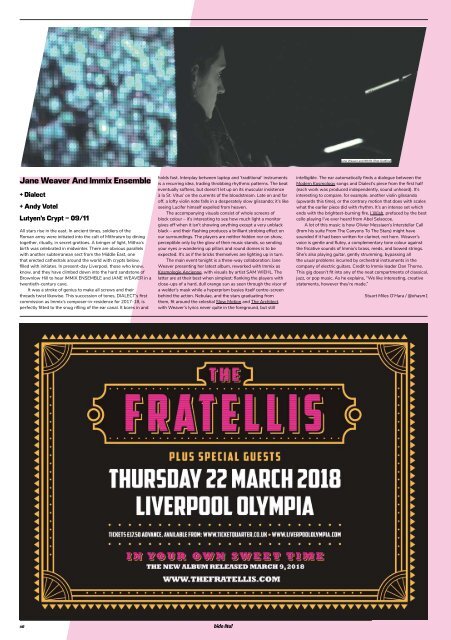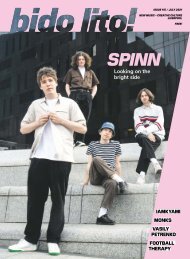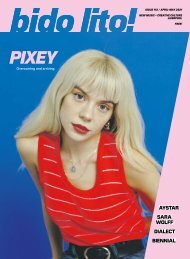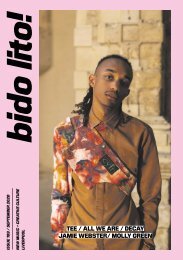Issue 84 / Dec 2017/Jan 2018
December 2017/January 2018 issue of Bido Lito! Featuring LO FIVE, TAYÁ, NICK POWER, MAC DEMARCO, LIVERPOOL MUSIC WEEK 2017 REVIEW and much more. Plus a special look at our need for space and independent venues, coinciding with a report into the health of Liverpool's music infrastructure.
December 2017/January 2018 issue of Bido Lito! Featuring LO FIVE, TAYÁ, NICK POWER, MAC DEMARCO, LIVERPOOL MUSIC WEEK 2017 REVIEW and much more. Plus a special look at our need for space and independent venues, coinciding with a report into the health of Liverpool's music infrastructure.
Create successful ePaper yourself
Turn your PDF publications into a flip-book with our unique Google optimized e-Paper software.
<strong>Jan</strong>e Weaver and IMMIX (Rob Godfrey)<br />
<strong>Jan</strong>e Weaver And Immix Ensemble<br />
+ Dialect<br />
+ Andy Votel<br />
Lutyen’s Crypt – 09/11<br />
All stars rise in the east. In ancient times, soldiers of the<br />
Roman army were initiated into the cult of Mithraism by dining<br />
together, ritually, in secret grottoes. A bringer of light, Mithra’s<br />
birth was celebrated in midwinter. There are obvious parallels<br />
with another subterranean sect from the Middle East, one<br />
that erected cathedrals around the world with crypts below,<br />
filled with initiates. In present-day Liverpool, those who know,<br />
know, and they have climbed down into the hard sandstone of<br />
Brownlow Hill to hear IMMIX ENSEMBLE and JANE WEAVER in a<br />
twentieth-century cave.<br />
It was a stroke of genius to make all screws and their<br />
threads twist likewise. This succession of tones, DIALECT’s first<br />
commission as Immix’s composer-in-residence for <strong>2017</strong>-18, is<br />
perfectly fitted to the snug rifling of the ear canal. It bores in and<br />
holds fast. Interplay between laptop and ‘traditional’ instruments<br />
is a recurring idea, trading throbbing rhythmic patterns. The beat<br />
eventually softens, but doesn’t let up on its muscular insistence<br />
à la St. Vitus’ on the currents of the bloodstream. Late on and far<br />
off, a lofty violin note falls in a desperately slow glissando; it’s like<br />
seeing Lucifer himself expelled from heaven.<br />
The accompanying visuals consist of whole screens of<br />
block colour – it’s interesting to see how much light a monitor<br />
gives off when it isn’t showing anything except a very unblack<br />
black – and their flashing produces a brilliant strobing effect on<br />
our surroundings. The players are neither hidden nor on show,<br />
perceptible only by the glow of their music stands, so sending<br />
your eyes a-wandering up pillars and round domes is to be<br />
expected. It’s as if the bricks themselves are lighting up in turn.<br />
The main event tonight is a three-way collaboration: <strong>Jan</strong>e<br />
Weaver presenting her latest album, reworked with Immix as<br />
Kosmologie Ancienne, with visuals by artist SAM WIEHL. The<br />
latter are at their best when simplest: flanking the players with<br />
close-ups of a hard, dull orange sun as seen through the visor of<br />
a welder’s mask while a hyperprism busies itself centre-screen<br />
behind the action. Nebulae, and the stars graduating from<br />
them, fit around the celestial Slow Motion and The Architect,<br />
with Weaver’s lyrics never quite in the foreground, but still<br />
intelligible. The ear automatically finds a dialogue between the<br />
Modern Kosmology songs and Dialect’s piece from the first half<br />
(each work was produced independently, sound unheard). It’s<br />
interesting to compare, for example, another violin glissando<br />
(upwards this time), or the contrary motion that does with scales<br />
what the earlier piece did with rhythm. It’s an intense set which<br />
ends with the brightest-burning fire, I Wish, prefaced by the best<br />
cello playing I’ve ever heard from Abel Selaocoe.<br />
A lot of this music is how Olivier Messiaen’s Interstellar Call<br />
(from his suite From The Canyons To The Stars) might have<br />
sounded if it had been written for clarinet, not horn. Weaver’s<br />
voice is gentle and flutey, a complementary tone colour against<br />
the fricative sounds of Immix’s brass, reeds, and bowed strings.<br />
She’s also playing guitar, gently strumming, bypassing all<br />
the usual problems incurred by orchestral instruments in the<br />
company of electric guitars. Credit to Immix leader Dan Thorne.<br />
This gig doesn’t fit into any of the neat compartments of classical,<br />
jazz, or pop music. As he explains, “We like interesting, creative<br />
statements, however they’re made.”<br />
Stuart Miles O’Hara / @ohasm1<br />
46


















